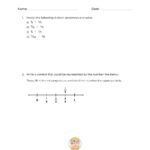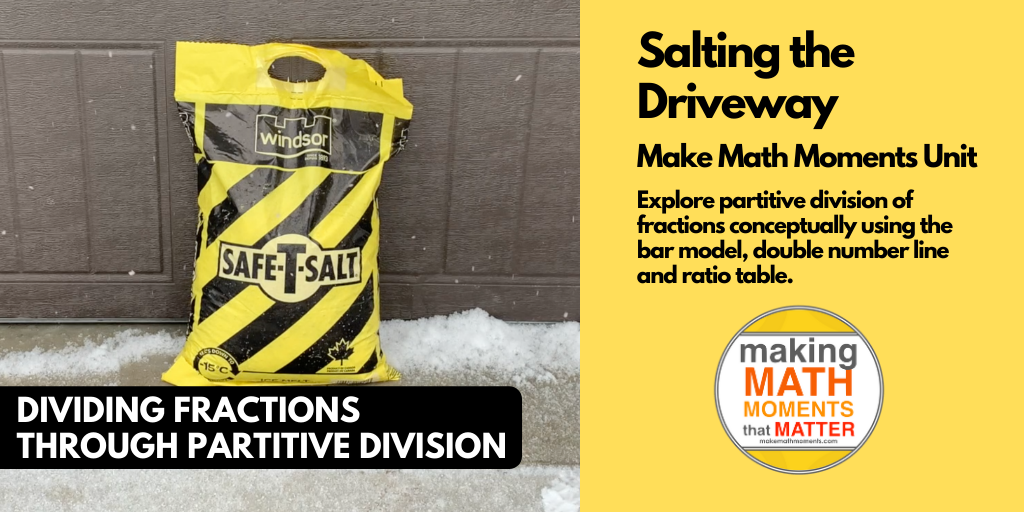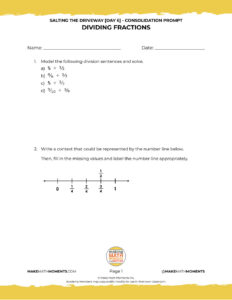Task Teacher Guide
Be sure to read the teacher guide prior to running the task. When you’re ready to run the task, use the tabs at the top of the page to navigate through the lesson.
Through This Assessment Opportunity…
Students will demonstrate the concepts and skills that they have developed through this context and learning experience.
Intentionality…
The purpose of this assessment is for students to demonstrate their understanding of the following big ideas.
- Partitive division is one of the two types of division;
- When dividing partitively, the dividend and the divisor often (not always) have two distinct units;
- The resulting quotient has a compound unit (quantity of dividend per one unit of divisor);
- The dividend and the divisor are a ratio before the division is performed;
- The quotient is a rate;
- The quotient can be revealed through scaling the ratio in tandem to one whole of the divisor;
- There are two ways to half a fraction:
- Half the numerator in order to half the number of parts while leaving the size of each part untouched (i.e.: half of \(\frac{4}{6}\) is \(\frac{2}{6}\)); or,
- Double the denominator. Double the number of parts that make up the whole by partitioning the existing parts in half, and keep the number of parts (the numerator) the same (i.e.: half of \(\frac{4}{6}\) is \(\frac{4}{12}\)).
The independent assessment will allow students to demonstrate concepts and skills related to the following learning goals:
- I will divide fractions.
- I will represent a division sentence involving fractions through a context and a model.
- I will use a fraction as an operator to scale quantities.
- I will demonstrate an understanding of ratios and rates.
- I will demonstrate an understanding of the relationship between ratios, rates and partitive division.
Students might write and/or model their answers independently. Students can also be interviewed by their teacher.
An alternative assessment opportunity should be offered if this tool will not successfully capture what the student knows, understands or can do.
Math Talk
Related String Of Problems
Present each division sentence one at a time. Encourage students to construct a context and model that could be represented by each sentence. Solve.
\(\frac{4}{5}\) ÷ \(\frac{2}{5}\)
\(\frac{6}{7}\) ÷ \(\frac{3}{4}\)
Login/Join to access the entire Teacher Guide, downloadable slide decks and printable handouts for this lesson and all problem based units.
Assessment
Assessment Considerations…
Login/Join to access the entire Teacher Guide, downloadable slide decks and printable handouts for this lesson and all problem based units.
Assessment: Dividing Fractions Through Partitive Division
Question #1:
Login/Join to access the entire Teacher Guide, downloadable slide decks and printable handouts for this lesson and all problem based units.
Question #2:
Login/Join to access the entire Teacher Guide, downloadable slide decks and printable handouts for this lesson and all problem based units.
Question #3:
Login/Join to access the entire Teacher Guide, downloadable slide decks and printable handouts for this lesson and all problem based units.
Question #4:
Login/Join to access the entire Teacher Guide, downloadable slide decks and printable handouts for this lesson and all problem based units.
Question #5:
Login/Join to access the entire Teacher Guide, downloadable slide decks and printable handouts for this lesson and all problem based units.
Considerations to Promote Student Growth
Based on the student thinking demonstrated on this assessment, provide students with descriptive feedback – written, verbal, or both – which includes next steps students should take in order to promote extending what they know, understand and can do.
Since assessment should be an opportunity for students to learn and for the teacher to understand where a student is in their learning journey, this should not close the door on these big ideas, models, and strategies.
What opportunities can you provide students with to demonstrate any further learning they engage in after this assessment day?
Download Editable/Printable Handout
Become a member to access purposeful practice to display via your projector/TV, download the PDF to upload to your LMS and/or print for students to have a physical copy
Resources and Downloads
Lesson Tip Sheet

Download the lesson plan in PDF format so you can keep it handy and share with colleagues.
Videos & Images
 Download the videos, images, and related media files to your computer to avoid streaming.
Download the videos, images, and related media files to your computer to avoid streaming.
Keynote Slides
 Download in Apple Keynote format to avoid streaming video and run the lesson smoothly.
Download in Apple Keynote format to avoid streaming video and run the lesson smoothly.
PowerPoint Slides
 Download in Microsoft PowerPoint format to avoid streaming video and run the lesson smoothly.
Download in Microsoft PowerPoint format to avoid streaming video and run the lesson smoothly.
Printable Handout

Download/edit the handout so you can keep it handy and share with colleagues.
Explore The Entire Unit of Study
This Make Math Moments Task was designed to spark curiosity for a multi-day unit of study with built in purposeful practice, and extensions to elicit and emerge mathematical models and strategies.
Click the links at the top of this task to head to the other related lessons created for this unit of study.
What is…
\(\frac{4}{5}\) ÷ \(\frac{2}{5}\)
…
\(\frac{6}{7}\) ÷ \(\frac{3}{4}\)
…
Login/Join to access the entire Teacher Guide, downloadable slide decks and printable handouts for this lesson and all problem based units.
…
Login/Join to access the entire Teacher Guide, downloadable slide decks and printable handouts for this lesson and all problem based units.
…
Login/Join to access the entire Teacher Guide, downloadable slide decks and printable handouts for this lesson and all problem based units.
1. Model the following…
Login/Join to access the entire Teacher Guide, downloadable slide decks and printable handouts for this lesson and all problem based units.
2. Write a context…
Login/Join to access the entire Teacher Guide, downloadable slide decks and printable handouts for this lesson and all problem based units.
3. Joe used…
Login/Join to access the entire Teacher Guide, downloadable slide decks and printable handouts for this lesson and all problem based units.
4. Complete the…
Login/Join to access the entire Teacher Guide, downloadable slide decks and printable handouts for this lesson and all problem based units.
5. Rayhan says…
Login/Join to access the entire Teacher Guide, downloadable slide decks and printable handouts for this lesson and all problem based units.
Download Editable/Printable Handout
Become a member to access purposeful practice to display via your projector/TV, download the PDF to upload to your LMS and/or print for students to have a physical copy




